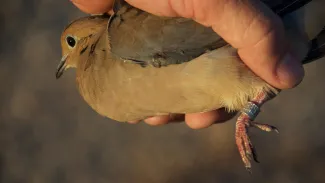Dove Hunters We Need Your Help

Mourning doves are one of the most widely distributed and abundant birds in North America. Mourning doves are also a popular game bird with hunting seasons established in 37 of the lower 48 states. There are more mourning doves harvested than all other migratory game bird species combined. In Oklahoma, an estimated 24,600 hunters harvested more than 480,000 mourning doves in 2007.
Because of the importance of the mourning dove as a migratory game bird, wildlife managers require certain information from which to guide harvest management decisions. Information on dove survival and harvest rates are keys to understanding the effects of annual hunting regulations on mourning dove populations. Banding is the primary tool used to obtain this information
This summer, Oklahoma along with all other states in the Central Management Unit (CMU), will be participating in a nationwide mourning dove banding program. The objectives of this program are to determine mourning dove harvest rates, estimate annual survival, and provide information on the geographical distribution of the harvest.

Doves will be marked with metal leg bands containing a unique number and a website that hunters can use to report the band. In return, wildlife managers receive important information on the number of banded doves harvested and location and date of harvest. More than 14,000 doves will be trapped and banded yearly in the 14 states of the CMU.
In Oklahoma, a number of dove banding sites will be established using wire funnel traps baited with grain to capture mourning doves. Banding sites will be pre-baited for a period of time in early summer to get doves accustomed to using a trapping site and then traps are set in late summer and actual banding commences. Doves enter the traps in search of the placed grain through funnel openings and cannot find their way back out because of the traps design. Traps are regularly checked and trapped doves are removed and carefully examined to determine their age and sex based upon feather color and patterns of feather replacement and wear. Doves are then banded with U.S. Fish and Wildlife Service bands inscribed with unique numbers and the website and immediately released.

Hunters are a critical link in this mourning dove banding study. By checking all harvested doves for bands, and reporting banded doves, you help us manage this important migratory game bird resource. Because dove bands are very small, hunters can easily overlook them. We are asking dove hunters to carefully check all doves harvested for the presence of a leg band. If you harvest a banded mourning dove please report it by logging on to http://www.reportband.gov/. Banded doves may also be reported by phone by calling 1-800-327-BAND (2263). Hunters can keep the band and will be provided a certificate of appreciation that identifies who banded the bird, the age and sex of the bird, and the date and location where the bird was banded.